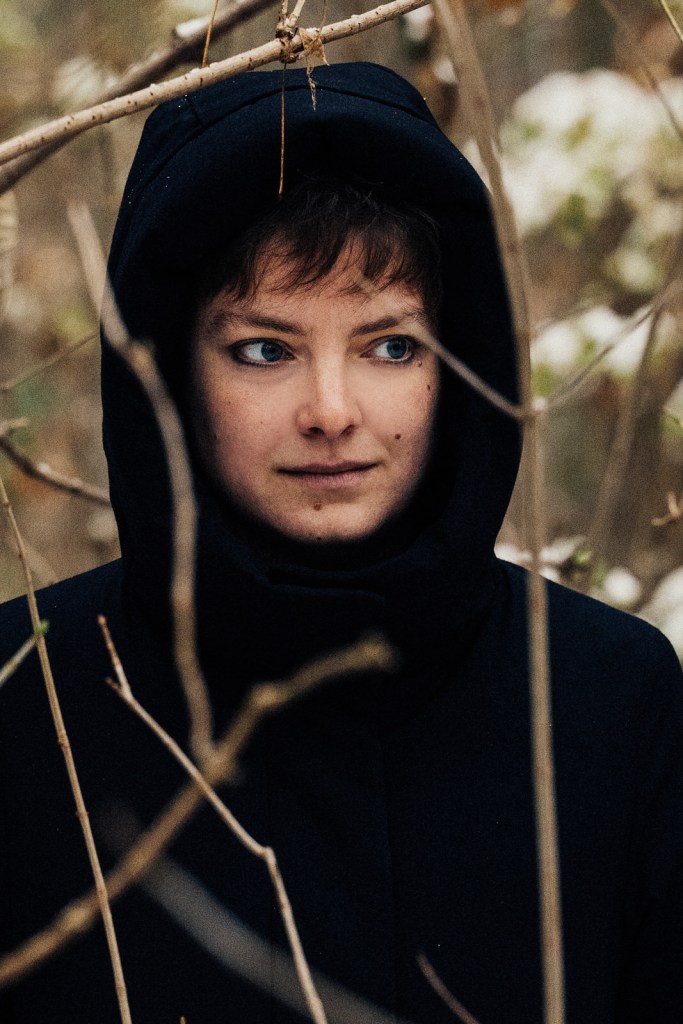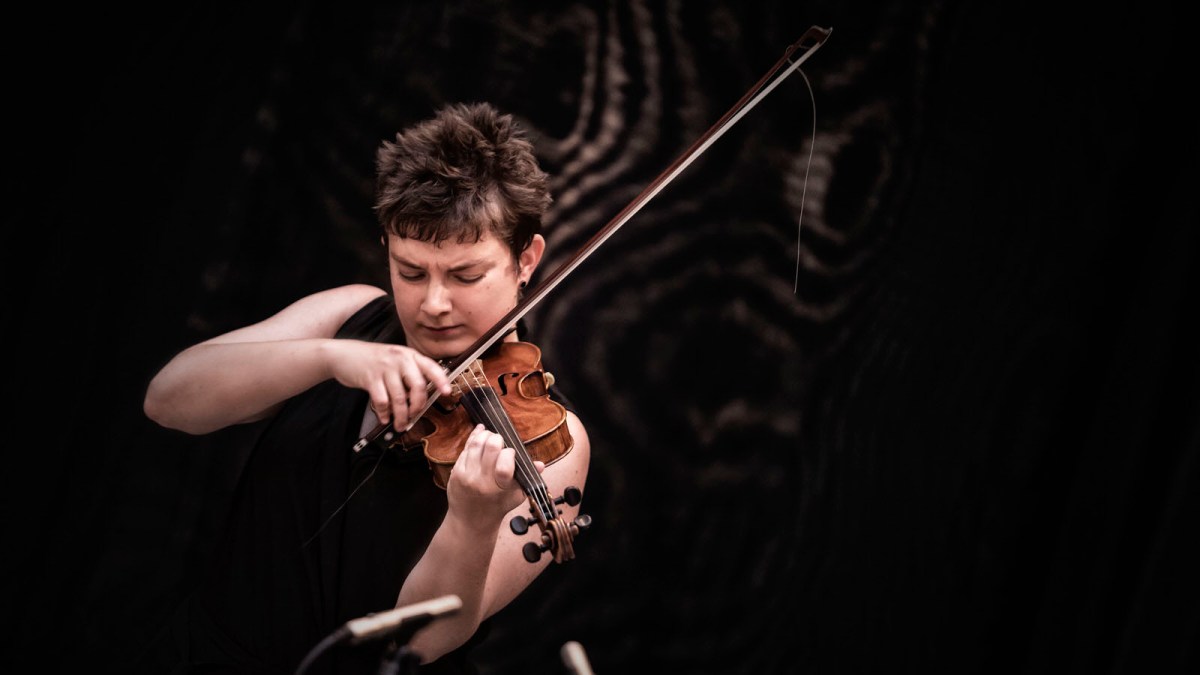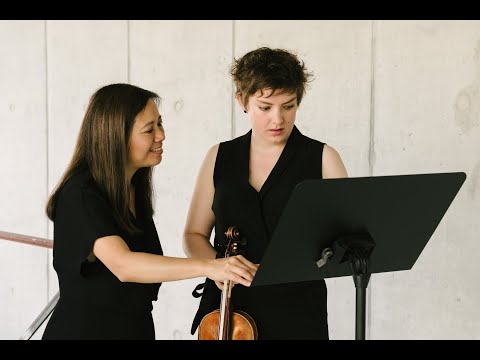It is afternoon in Berlin. Sarah Saviet is not meant to be here. She is meant to be hiking, unreachable in the woods in Spain, but, change of plans, she’s here, playing Bach: in her living room, an afternoon in Berlin. And so we meet.
We talk, and we do not cover everything. She is kind, and agrees to meet again. We set a time; we say goodbye.
The second day comes, and we meet. Already on her kitchen table is a small spiral notebook, blue floral. Four small hedgehogs, doodled in blue pen, crawl tightrope across the line where a title should be. She sits, thumbs, locates a page of notes drawn up in the interim (outrageously prepared). At the top of the page, the following quotation, copied from Austrian artist Anni Albers’ treatise “On Weaving.” She reads it aloud:
We touch things to assure ourselves of reality. We touch the objects of our love. We touch the things that we form.
“Fuck,” says Saviet, breathless. “Isn’t that mind-blowing?”
She articulates her T’s when she speaks.
It really is, I tell her, and we talk about it for a long time. We do not cover everything.
We might talk about it some more.
Why not do so?
—[Albers’ three totems, each in their own turn; one at a time, carefully:]
I. Reality (“We touch things to assure ourselves of reality.”)
She is an ever-moving target. Busy, yes—at 34, Saviet is one of new music’s most sought-after violinists—but it’s a chameleonic versatility that makes her so hard to pin down. In a field of self-professed specialization, she really does everything: shreds the solo in a Liza Lim concerto, subs violin tutti with the Berlin Philharmonic, leads gender-bent chamber music-theater, all without batting an eye. Her Bach is as good as her Cat Lamb—she’s a regular with the Harmonic Space Orchestra—but intensely complicated and fragile music is equally up her alley: she can play Evan Johnson like the best of them. Over the summer, she curated site-specific improv for community musicians in Darmstadt. Now she’s writing music for her duo with pianist Joseph Houston. It’s a rare agility, to do so much so well.
And that still doesn’t cover the technical side, because Saviet is also an uncommonly adept administrator. She serves as an artistic coordinator for ensembles across Europe, a frequent curator in Berlin, and an on-call organizer for the most audacious projects. She has the general knack for “how things get done” that most musicians are born without, and has made a name for herself as a leader as much as a performing artist. Her life—self-professed—is lived mostly on trains these days.
And so it surprises me that, amidst so much hairpin, surgical precision, she talks so openly of failure.
“I like having several things going on at once,” she tells me, “and at least two of them have to be things I don’t know how to do. Sometimes I think I’m unfocused and I do too many things—why am I learning Baroque violin, and why am I doing it now?—but I think that’s my thread: I need to feel like I’m flopping around and unsure of myself to balance out the control and constant knowing. Together, they help me access a space where I’m really open and listening.”
Her attraction to failure is most evident in solo work, where her playing is characterized by a willingness to linger at danger’s absolute threshold. With permission from the composer, she recently rewrote Bryn Harrison’s “A Coiled Form” to six times its original length, a near-deadly test of endurance and dexterity. Often, she’s forced to take several days off on the backend to recover from the strain. But, she says, she’s willing to risk those physical limits because the project is rooted in rigor and preparation, her form of collaborative tenderness.
“Research for me is such an important part of getting to the dangerous space of failure,” she continues. “There has to be so much knowledge acquired before arriving in that space to feel confident enough in my own ability to make the music make sense. What are the realms of language in which this music exists? What is its sensibility? The richer the backstory I come with, the more I can step away from the page, because I’ve filled out the house with the furniture.”
That stepping away from the page, however, is more to the point. Paradoxically, it is only by knowing a music inside and out that she can give her body space enough to protest. When, after weeks of preparation, the fingers or the musculature don’t quite match with the ideal demands of the music, her body begins to make itself heard, nuancing the curvatures of time and motion to the idiosyncratic needs of her physicality. Which is what makes it “Sarah Saviet plays Liza Lim” and not “a good performance of Liza Lim.” When I mentioned this to Lim—whom the violinist cites as one of her strongest influences; Lim’s “Su Song Star Map” opens Saviet’s new album “Spun”—the composer emphasizes that same remarkable duality:
I remember working with Sarah on “The Su Song Star Map” which involves a continuous balancing act between violin, fingers and bow, when it was like all effort disappeared; the violin was playing her as she played it; this incredible throaty sound came out and it was like hearing the secret voices of the violin, the music and Sarah all at once.
Saviet’s capacity to so fully embody the varying languages of new music without ever losing an individuated sound is a direct result of her investment in her own private failure. It is her way of touching being at its most fragile, her direct access to her sense of self, a reminder to herself that she, too, is in the room with the music. In performance, she does not disappear behind a perfectly executed (that word also means dead) rendition. She leans towards fallibility, loving the grain where vulnerability subducts ego to unveil the true body beneath.
After a solo recital in Würzburg, Germany last month, an audience member approached Saviet with the observation that “you’re really just playing the music, it’s not about you!” Saviet laughs at this as she recounts it, and then thinks for a moment: “Yeah… but what else would it be? I can’t force myself onto somebody else’s work. With any piece, the gift I get is to discover anew who I am in that space.”
II. Love (“We touch the objects of our love.”)
The bookcase is a cascading staircase of open boxes. It begins with a lone solitary cube, the upper left corner, and falls, accumulating along the diagonal until it reaches a row of four. All told, the structure partitions into ten self-contained units. The bookcase consumes the living room wall.
There are three plants, a ponytail palm, a healthy bergeranthus in classic terracotta, and an aloe vera, small but still prolific. Adjacent to the aloe is a female nude, simple pencil silhouette tacked to the wall. At her breast, she holds a panicle of red and yellow florals which spill beyond the limits of her body, as if reaching for their living nearby sisters. There are also four decorative animals: a small stuffed mouse nestled alongside the bergeranthus, a large piglet, richly patterned, and a pair of stuffed hedgehogs. One is small and the other large, the littlest one is blue, and they both angle out towards the gray Berlin sky.

The books begin in earnest with the second row of the shelves. The first book, pride of place, is—who else?—Anni Albers. A for Albers, an inevitability of alphabet. Except no, because book two comes careening from the opposite end: Hengameh Yaghoobifarah’s Ministerium der Träume, the journalist’s debut novel about sister suicide, immigrant Otherness, and queer motherhood in contemporary Germany. All obvious organization has gone out the window, so check the third: Bauhaus Weaving Theory, a solid recall to Albers, but Audre Lorde comes fourth and skews back towards radical feminism. Alternating subjects? No, Sheila Heti’s Motherhood (5) is another rebound to the territory of Yaghoobifarah, but Lydia Davis (book 6) is a world unto her own. (Perhaps still motherhood? That’s tenuous at best.).
The shelf only comes to a dizzying head at its symmetrical center: a timeworn and well-loved copy of Maggie Nelson’s The Argonauts, book 7, and suddenly we’re starting to get somewhere. Nelson—and her dazzling account of gender, maternity, queerness, art, autotheory, and philosophy—functions as a kind of nexus, a place where the bands of emerging material begin to assume some recognizable form. Art and motherhood, linked by femininity; motherhood and queerness, elided by communal care-taking; queerness and ethics, linked by love. And now the receding zipper makes considerably more sense: Kae Tempest nuzzles aside Kim de L’Horizon without any protest, and Elfriede Jelinek cozies up with Judith Butler, maybe not logical, but sensible.
This ends the first box.
The threshold of box two is broached by a lean-to pair: Black Vodka, the first of several Deborah Levy novels (Hot Milk is the only absentee, currently open on a nightstand a room away) and a heavily-underlined copy of Jack Halberstram’s critical juggernaut The Queer Art of Failure. (A dog-eared page of that book turns up the highlighted following: “The goal is to lose one’s way, and indeed to be prepared to lose more than one’s way.”) There’s a more-or-less sorted set of poetry: Rankine first, followed by a thick yellow tome of Hafiz (a staple for anyone with close ties to Liza Lim), Rilke, Eliot, then Sarah Kay. Ocean Vuong hugs Mary Oliver (actually, Ocean’s not so privileged here: Mary Oliver is everywhere). And then a last act twist: out of left field, Katie Mitchell’s The Director’s Craft. A technical theater book—wildly misplaced? But on closer inspection, a book about people and space, about how to create spaces for people, and how to invite people to spaces has a place here. Somehow—the thread is oblique, but luminous still—there is shared ground. Finally, Braiding Sweetgrass, and this ends the second box.
The books continue on like this for six more cubes. Writers hardly ever appear in like kind—none of the three Albers volumes are even remotely near the other—but there is a rhythm, an internal guiding hand which interlaces subjects on the grounds of something more private, more speculative and peripheral. Alone, no single book reveals the whole. Together, though, they whisper of shared priorities, of a reader ineluctably drawn to how bodies and ideas speak to one another at their edges.

A light breeze from the cracked window rustles in the ponytail fronds. In the other room, Bach is playing.
(“I’m not interested in showing composers my ‘bag of tricks’ anymore. For me, collaboration is about what books we’re reading, what sounds we like to hear, what we’re thinking about artistically: it’s about connecting on the level of who we are.”)
The latest from VAN, delivered straight to your inbox
III. Form (“We touch the things that we form.”)
Form is slippery. Often it’s talked about like some grand external scaffold, but it really has more to do with interiors, with material, with the emergent discourse between local-level detail and global experience and how each informs the other. Form is crucially distinct from structure that way, structure being only order, bare and brutal (ten boxes, diagonal, delimited). Form is contingency: the way books weave over boundaries, humming towards a whole. Form is what is discovered; form is what’s inside. Albers, in her second treatise “On Designing”:
Losing ourselves in the task, we would be giving free play to our inventive energies and would arrive at a result that is not individualistically limited. Instead of cultivating in our work a personal handwriting, a personal style would unavoidably evolve, unexaggerated, unsought. And since our concern as craftsmen is an aesthetic solution, even when focusing on practical aspects, we would be led naturally to a result that would satisfy our sense of form, a form that has grown with the development of the object, and is not additive but inherent.
The things we form in this field are people and not works. We do not make intractable objects. Music—sound, time—is an impression on bodies: it makes us, in the sense that our very being “grow[s] with the development of the object.” Performers learn to hold music in their fingers, lungs, tracheae, they imbibe and adopt non-native sensibilities while striving to maintain idiosyncratic autonomy in fragile tandem. It is an infective process, one that transforms the body from within while actively implicating its limitations: acoustic music takes a form only as it finds one in an imperfect human musculature. Music is the reaching towards ourselves.
Saviet knows this. Her recourse to the accidental as a mode of self-knowledge is a conscious effort to override the score-as-God assumption: what matters most is the sounding body, even—or especially—when it falls short. Cultivating spaces where failure is permitted rescinds power from the rapid mechanization that characterizes our economy of newness. It shifts priority from the unfeeling facticity of the score-object to the fallible, breathing bodies sharing space in the work of realization. It encourages play, creativity, flexibility, change, trial-and–error. We make better music in spaces where failure is invited because our bodies—the place of music’s form—are more wholly and authentically involved. And that, Saviet says, demands care.
“Facilitating a space in which failure is a safe and welcomed option requires care.” Her voice is urgent now. “It’s a kind of work, taking care of one other. There’s no feeling like entering a space where you feel safe to play and experiment; we can never take that for granted.”
Suddenly all the books on mothering and queer maternity come sharply into focus. Suddenly the texts on stage direction and instinct-based art practices make perfect sense. They reflect, like her administrative projects, Saviet’s ongoing search for models of compassion and protection that can be productively activated to ease the hierarchies and tensions of performer-composer/body-work relations. What makes her such a strong facilitator is also what defines her consummate musicianship: she prioritizes care over correctness, knowing, above all else, that our capacity to fail is the truest measure of who we really are.
In a field too often blinded by fidelity to accuracy, Sarah Saviet is, with insistence but not force, asking that we rethink how we care for one another, for our music, and for ourselves: these, the things we form. ¶
Subscribers keep VAN running!
VAN is proud to be an independent classical music magazine thanks to our subscribers. For just over 10 cents a day, you can enjoy unlimited access to over 875 articles in our archives—and get new ones delivered straight to your inbox each week.
Not ready to commit to a full year?
You can test-drive VAN for one month for the price of a coffee.




